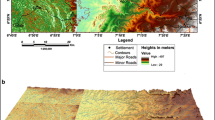Abstract
It is anticipated that after the design life of roads, the pavement materials should have extensively deteriorated necessitating reconstruction/rehabilitation. The extent to which these materials deteriorate in terms of their geotechnical properties has not been fully understood. This study evaluated the extent of deterioration of a typical marginal, mechanically stabilised lateritic crushed rock base in the Kumasi city roads after over 25 years’ in-service. As-constructed materials properties were compared with post-design life properties to determine the degree of alteration of geotechnical, chemical, and mineralogical properties. Results of the study indicate that: the in-situ mean moisture content reduced by about 16% over the service period. The grading changed significantly producing mean fines contents of over 200%. The mean liquid limit and plasticity index were 40% and 22%; equivalent to about 16% and 70% increase respectively. The in-situ-resilience moduli were between 574 and 603 MPa, indicating a significant reduction of about 81–82%. The base materials had similar chemical composition with dominant oxides being silica, alumina and iron oxides with mean concentrations of 52.4%, 28% and 6.5%, respectively. Quartz, kaolinite, albite, and rutile were the minerals identified with no swelling clays present. In conclusion, although the mechanically stabilised lateritic base material during construction did not meet the specification strictly, the pavement performed beyond the design life. In addition, despite the deterioration in material properties, the base layer generally still possesses adequate resilience moduli and mineralogical stability to enable continual use during rehabilitation, except for zones with resilience modulus less than 200 MPa, which require strengthening.










Similar content being viewed by others
Data Availability
Enquiries about data availability should be directed to the authors.
References
AASHTO T 307 (2004) Determining the resilient modulus of soils and aggregate materials (2012), American Association of State Highway and Transportation Officials, Washington, DC, USA, 41 pp
Alexander LT, Cady JG (1962) Genesis and hardening of laterite in soils. US Dept Agric Tech Bull 1282:90
Amu OO, Ogunniyi SA, Oladeji OO (2011) Geotechnical properties of lateritic soil stabilized with sugar cane straw ash. Am J Sci Ind Res 2:323–331
Bai W, Kong L, Guo A (2013) Effects of physical properties on electrical conductivity of compacted lateritic soil. J Rock Mech Geotech Eng 5:406–411. https://doi.org/10.1016/j.jrmge.2013.07.003
BRRI (1985) Highway geotechnical characteristics of selected subgrade materials. Technical Paper HM/5 Paper 10, 134 pp
BRRI (1995) Rehabilitation of the Kumasi City Roads, Final Report. 68pp
BS 1377(1990) Methods of testing soils for civil engineering purposes. British Standards Institution, London, 143 pp
De Graft-Johnson JWS, Bhatia HS, Hammond AA (1972) Laterite gravel evaluation for road construction. J Soil Mech Found Eng Am Soc Civ Eng 98:1245–1265
De Medina J, Motta LMG, Dos Santos JDG (2006) Deformability characteristics of Brazilian laterites. Geotech Geol Eng 24:949–971. https://doi.org/10.1007/s10706-005-8507-z
Fall M (1993) Identification et caractérisation mécanique des graveleux latéritiques du Sénégal: Application au domaine routier. Thèse de l’I.N.P.L
Fekpe E, Attoh-Okine NO (1995) Deterioration modelling for lateritic-base flexible pavements. Constr Build Mater 9(3):159–163
Garg SK (2009) Soil mechanics and foundation engineering, 7th edn. Khana Publishers, New Delhi, pp 673–683
Gawu SKY, Gidigasu SSR (2013) The effect of spent carbide on the geotechnical characteristics of two lateritic soils from the Kumasi area. Int J Eng Res Technol 6(3):311–321
Gidigasu MD (1976) Laterite soil engineering. Elsevier, Amsterdam
Gidigasu MD (1980) Some contributions to tropical soils engineering in Ghana. In: “Special Lecture”: 7th regional conference for Africa on soil mechanics and foundation engineering, Accra, vol 2, pp 508–626
Gidigasu MD (1983) Development of acceptance specifications for tropical gravel paving materials. Eng Geo 19:213–240
Gidigasu MD, Kuma DOK (1987) Engineering significance of laterisation and profile development processes. In: Proceedings on 9th regional conference for Africa on soil mechanics and foundation engineering, Lagos, pp 3–20
Kavussi A, Abbasghorbani M, Mogahadas Nejad F, Bamdad Ziksari A (2017) A new method to determine maintenance and repair activities at network-level pavement management using falling weight deflectometer. J Civ Eng Manag 23(3):338–346
Mahalinga-Iyer U, Williams DJ (1997) Properties and performance of lateritic soil in road pavements. Eng Geol 46:71–80
Ministry of Roads and Highway (MRH), Ghana (1991) Standard specifications for road and bridge works. Accra, Ghana
Mu’azu MA (2007) Influence of compactive effort on bagasse ash with cement treated lateritic soil. Leonardo Electron J Pract Technol 10:79–92
Netterberg F (2014) Review of specifications for the use of laterite in road pavements. United Kingdom Department for International Development (Contract: AFCAP/GEN/124), 66 pp
Nogami JS, Villibor DF (1991) Use of lateritic fine-grained soils in road pavement base courses. Geotech Geol Eng 9:167–182
Rossiter DG (2004) Digital soil resource inventories: status and prospects. Soil Use Manag 20(3):296–301
Acknowledgements
The authors are grateful to the Building and Roads Research Institute, Ghana, and the Department of Urban Roads, Ashanti Region, for providing data for this work. Mr Stephen Akosah, who assisted with sampling and geotechnical testing of samples, is greatly acknowledged.
Funding
The authors have not disclosed any funding sources.
Author information
Authors and Affiliations
Corresponding author
Ethics declarations
Conflict of interest
The authors declare that they have no conflict of interest.
Additional information
Publisher's Note
Springer Nature remains neutral with regard to jurisdictional claims in published maps and institutional affiliations.
Rights and permissions
About this article
Cite this article
Gidigasu, S.S.R., Gawu, S.K.Y. & Owusu-Nimo, F. The Extent of Deterioration of a Mechanically Stabilised Lateritic Base Course After Design Life and Its Implications for Rehabilitation: A Case Study of Kumasi City Roads, Ghana. Geotech Geol Eng 40, 4301–4311 (2022). https://doi.org/10.1007/s10706-022-02156-z
Received:
Accepted:
Published:
Issue Date:
DOI: https://doi.org/10.1007/s10706-022-02156-z




